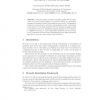Free Online Productivity Tools
i2Speak
i2Symbol
i2OCR
iTex2Img
iWeb2Print
iWeb2Shot
i2Type
iPdf2Split
iPdf2Merge
i2Bopomofo
i2Arabic
i2Style
i2Image
i2PDF
iLatex2Rtf
Sci2ools
101
click to vote
TSD
2004
Springer
2004
Springer
Advanced Prosody Modelling
Abstract. A formal prosody model is proposed together with its application in a text-to-speech system. The model is based on a generative of abstract prosodic functionally involved units. This grammar creates for each sentence a structure of immediate prosodic constituents in the form of a tree. Each prosodic word of a sentence is assigned with a description vector by a description function and this vector is used by a realization function to create appropriate intonation for the prosodic word. Parameters of the model are automatically set up using real speech data from a prosody corpus, which is also described.
Related Content
| Added | 02 Jul 2010 |
| Updated | 02 Jul 2010 |
| Type | Conference |
| Year | 2004 |
| Where | TSD |
| Authors | Jan Romportl, Jindrich Matousek, Daniel Tihelka |
Comments (0)

